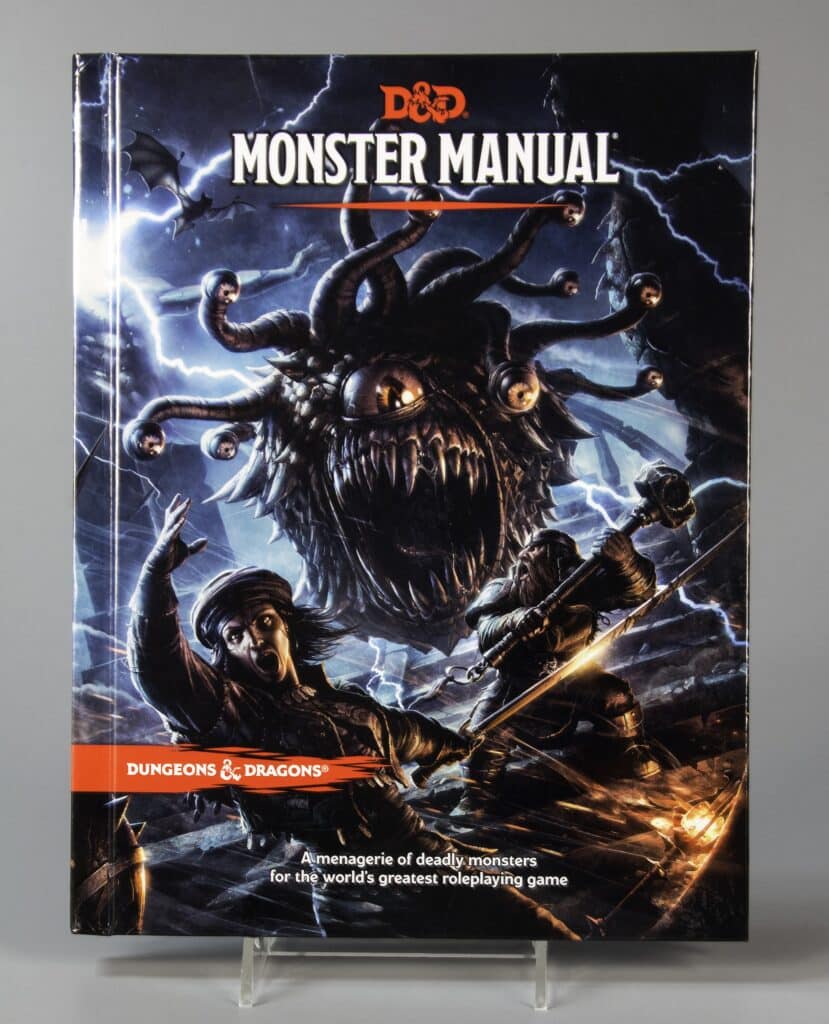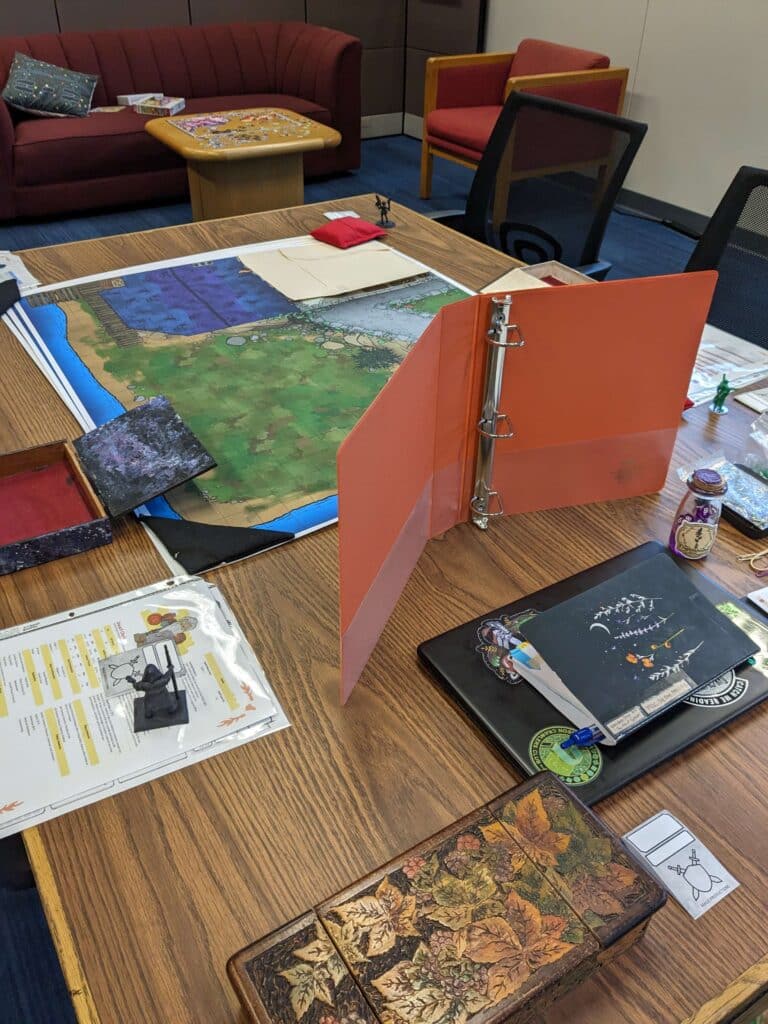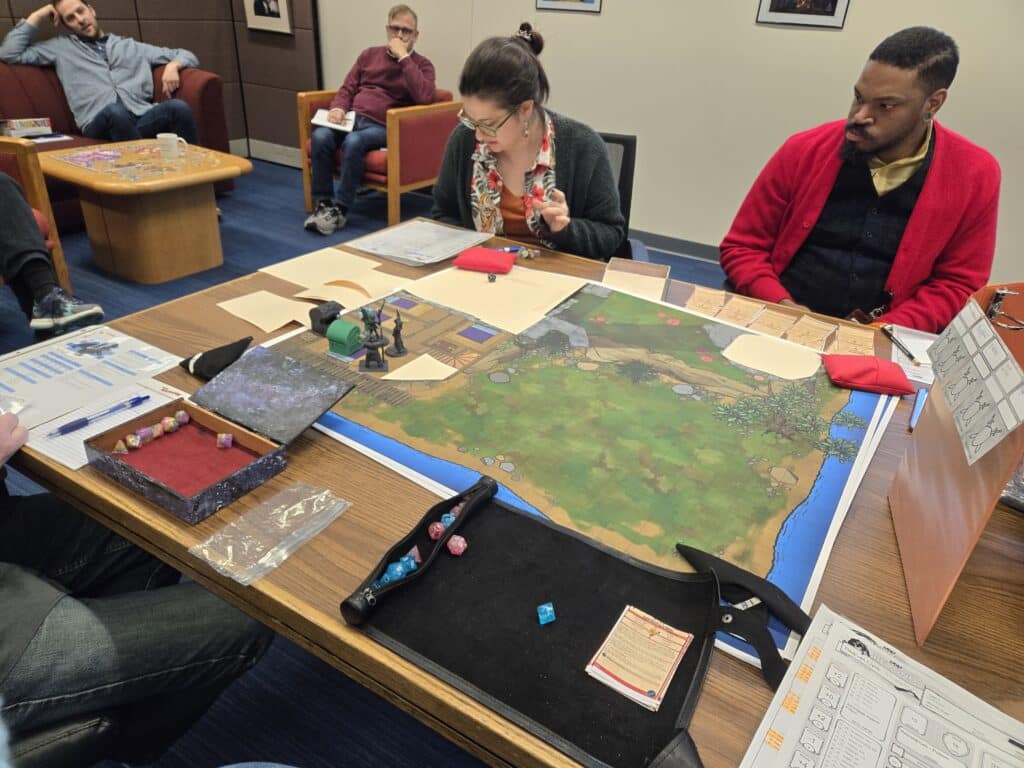It is always an exciting thing to have your personal hobbies suddenly become relevant to your work. But imagine my shock when I got asked by multiple teams here at The Strong Museum to run Dungeons and Dragons (D&D) games so that my colleagues could get familiar with the game in preparation for working on our Dungeons & Dragons: 50 Years of Storytelling exhibit!
While I have run multiple tabletop role-play games (TTRPG) for friends, I had only recently started dipping my toes into the role of Dungeon Master (DM) —the term used for the person who is running a Dungeons & Dragons campaign. Before this, I had also exclusively run games online, over a Discord voice call using Roll20, a virtual tabletop service. In that setting, we don’t use cameras for our games so no one can see my facial expressions as I do silly character voices or see me searching for music while players talk to each other. The idea of standing in front of people while doing this can be intimidating. And it is no wonder why DMs are harder to find than players in the TTRPG community—it’s a lot of work to prepare such a game, even a short one! Nonetheless, I undertook the challenge, hoping to share this wonderful game we were celebrating at the museum with my co-workers.

The first question was if I was going to undertake a homebrewed adventure or use something pre-written. I immediately decided since I had access to many published short adventures, we would use one of those, since I could be confident they had been tested and designed with beginners to the game in mind. I searched and searched online and consulted many modules I own, but nothing felt quite right for what was needed . . . that is until LEGO announced their Dungeons & Dragons: Red Dragon’s Tale set and free module. I couldn’t believe our luck that they were coming out with exactly what was needed: A short and sweet 5th edition module designed to teach the game to new players, complete with pre-made character sheets, a delightful silly adventure, and they even provided music to play alongside gameplay for DMs! Not only that, but Wizards of the Coast streamed an actual play of the module run by Anjali Bhimani, so I got to see how the module should play out.

While it had almost everything a few things were missing. For monster stat blocks or descriptions of certain spells and items, the module referred to the 2014 5th-Edition books, which thankfully the museum has in our collection. As a result, I was able to look up everything I needed and have those descriptions at the ready for the games. There also was the small issue that the LEGO set itself was not going to be released in time for our event, so maps and miniatures for the characters were going to have to be a little different. Thankfully the internet offers access to a wealth of wonderful people who provide 3D print files for miniatures as well as maps! And Martin Reinhardt, our Arcade Conservation Technician here at the museum, was happy to help in printing everything for us!

Map and miniatures, ready! Module, ready! Music at the ready! Now to teach a game that has been around for 50 years, has had multiple editions, and is intimidating for newcomers to approach. I fully acknowledge that Dungeons & Dragons is a lot to learn and can be hard to get into if all you see with the game are people rolling dice, doing math, accessorized with massive books that are essentially textbooks for the game. I also will fully admit to players I often do not know all the rules—I applaud those who have it all memorized though! So where to start? I knew we needed a game that was going to provide a very general overview of various encounters and the most used mechanics of the game.

The first sessions I ran for members of our Collections Team were with co-workers who had played TTRPGs or knew a little of them beforehand, so we could jump in more easily. We played the full module over the course of two 2.5-hour sessions. The second group, our Marketing Team, were almost all new to roleplay games, so I decided to consider what would have been helpful to me when I started playing this massive and intimidating game. Having dice provided and a sheet made for me was a must, plus a clear idea of what I could do during each round of combat felt like a good place to start. Carefully I put together little binders with sheets, spell cards, magical item cards, dry erase markers to mark off on the sheets with, a bag of dice, and this handy free PDF by Matthew Perkins that explains what players can do on their turns in combat in 5e. Perkins’ website even acknowledges in the description of the PDF that “This game is complicated!” and explains he made the sheets to help onboard new players.
With the binders made, I decided to also cut out some pieces of the LEGO module to narrow in on the experience of a “typical game.” I knew I wanted to have a combat encounter, some investigation, a small social encounter to get into the roleplaying, but I didn’t want us to linger too long on Skill Checks or posing optional scenes to players. Also, for both groups and in general as a DM, I am a huge fan of what is called “Rule of Cool” in my games. This means that while the game’s rules may say: you can only move x amount of feet and only do this, I say: if it sounds cool and is within reason then give it a try, let’s have a dice roll still determine if you can do it or not. I always try to provide the space for my players to find alternative solutions. This could mean allowing a player character to talk their way out of combat or to sneak around to avoid an encounter.
Providing the space for players to make the adventure theirs has always been a goal of mine as a DM. After all, to quote Matthew Mercer from Critical Role, “How do you want to do this?” is what we ask players when they are about to defeat a foe in combat! We provide the player with the moment to shine and take control of the narrative of how they want to finish the enemies. But it can be hard to answer this question when just learning TTRPGs. When we started one game and I asked a player this question, the player hesitantly started to describe their finishing blow during the first combat encounter. But by the end of the game, we had excited descriptions and gestures as our heroes saved the day from the evil sorcerer! To see this transformation in just over two hours was amazing and I was so happy to see everyone enjoying the game.
Getting to share this game that has generated so many stories and imaginations for half a century now with co-workers was truly a delight. And I was happy to have the opportunity to be the one to run a game for them. The experience also provided me with a moment to step back and remember that, despite all the books, lore, and changes to the game over the years, it is just that: a game. And having fun with it, adjusting it to the players is always important as a DM. So even though I was there to teach others, I also learned a great deal from this experience and am ready for more stories to tell, whether it be online with friends or at work!


